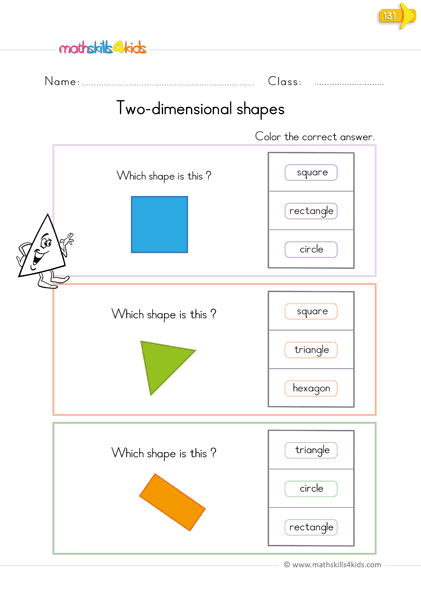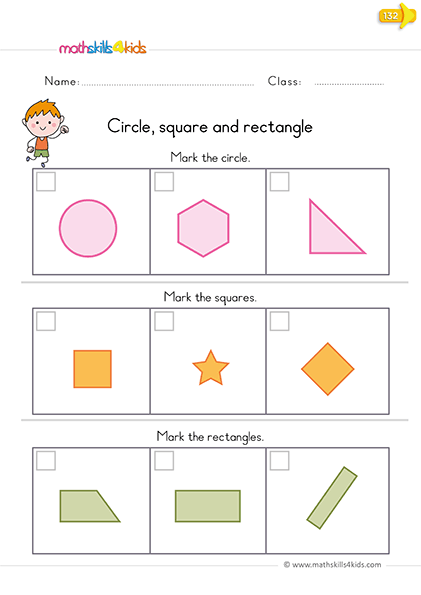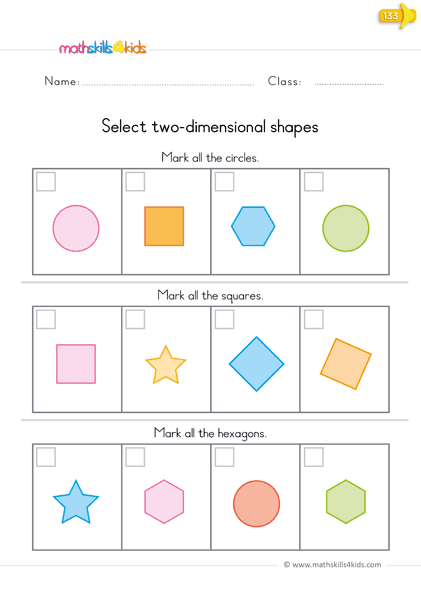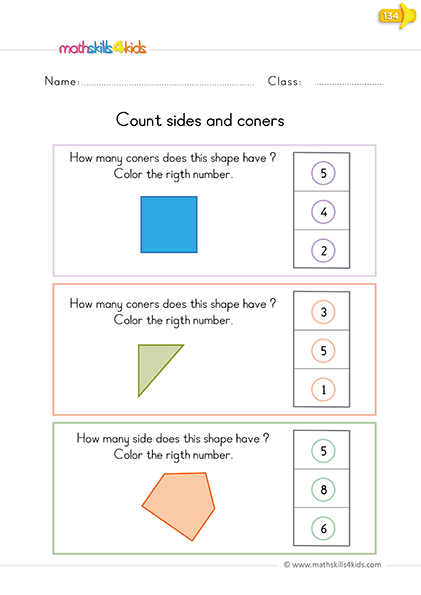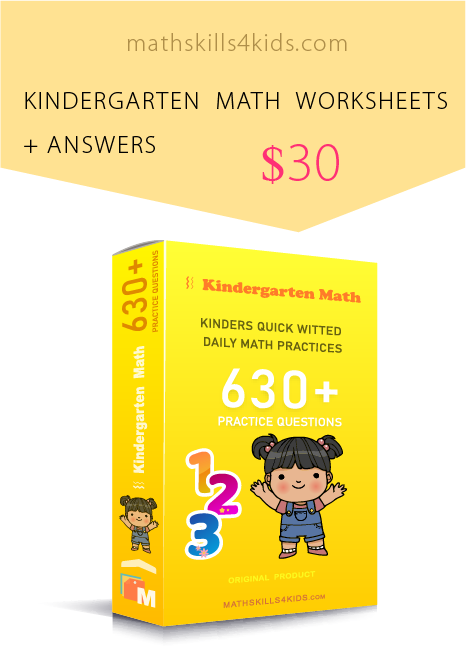Teaching 2D shapes to kindergarteners: Worksheets and activities
Are you looking for some fun and effective ways to teach 2D shapes to your kindergarteners? If so, you've come to the right place! In this article, we will share some of our favorite 2D worksheets and activities that we constantly use in the classroom to help kinders recognize, name, and describe 2D shapes.
-
You will also discover the learning objectives and standards for 2D shape recognition and some assessment and feedback strategies to monitor your student's progress.
After going through this interesting article, you will have many ideas and resources to make 2D shape learning a blast for your kindergarteners!
Introduction: Why 2D shapes matter for Kindergarteners?
You might be wondering why 2D shapes are so important for kindergarteners. After all, they are just simple figures like circles, squares, triangles, and rectangles, right? Well, not quite.
2D shapes are the building blocks of geometry and spatial reasoning, essential skills for future math learning. By learning about 2D shapes, kindergarteners develop their visual perception, pattern recognition, classification, and problem-solving abilities.
Kids will also learn to communicate mathematical thinking using precise vocabulary and examples.
Besides, 2D shapes are everywhere, from art and architecture to nature and design. So, by exposing kindergarteners to 2D shapes, we are helping them appreciate the beauty and diversity of shapes in their environment.
-
BROWSE THE WEBSITE
-
DOWNLOAD FREE WORKSHEETS
-
-
K- MATH TOPICS
- Learn to count up to 3
- Counting from 1 to 5
- Count up to 10
- Learn to count up to 20
- Counting to 100
- Skip counting
- Measurement
- Sum and difference
- Comparison
- Patterns
- Addition up to 5
- Addition up to 10
- Subtraction up to 5
- Subtraction up to 10
- 2D shapes
- Introduction to symmetry
- Position
- Fractions
- Time
- Classify
- Data and graph
- Probability
- 3D shapes
-
-
Learning objectives and standards for 2d shape recognition
Before diving into the worksheets and activities, look at kindergarten's learning objectives and standards for 2D shape recognition. According to the Common Core State Standards for Mathematics (CCSSM), by the end of kindergarten, students should be able to:
- Identify and describe 2D shapes (squares, circles, triangles, rectangles, hexagons, cubes, cones, cylinders, and spheres).
- Analyze, compare, create, and compose shapes.
- Model shapes in the world by building shapes from components (e.g., sticks and clay balls) and drawing shapes.
- Compose simple shapes to form larger shapes (e.g., join two triangles with full sides touching to make a rectangle).
These standards are aligned with the National Council of Teachers of Mathematics (NCTM) Process Standards for Mathematics, which emphasize the following skills:
- Problem-solving
- Reasoning and proof
- Communication
- Connections
- Representation
As you can see, learning about 2D shapes is about more than memorizing their names and attributes. It is also about developing critical thinking and communication skills to serve kindergarteners well throughout their math education.
-
Fun and engaging worksheets to practice 2d shape identification
Our fun and engaging worksheets from MathSkills4kids are perfect for practicing and identifying 2D shapes. All worksheets are printables and excellent tools for teaching and learning basic flat shapes.
These worksheets are created to reinforce the concept of 2D shapes taught in class, provide feedback on students' understanding, and challenge them to apply their knowledge in different contexts.
Here are some examples of fun and engaging worksheets that you can use in your classroom or at home:
-
Shape Bingo: This classic game can be adapted for any topic. Create a bingo card with different 2D shapes (you can use clip art or draw them yourself) and give one to each student. Then call out the names of the shapes randomly and have students mark them on their cards.
The first student to get five in a row (horizontally, vertically, or diagonally) wins!
-
Shape Sorting: This simple but effective activity helps students practice their classification skills. Give each student a set of cut-out 2D shapes (you can use different colors and sizes to make it more interesting) and have them sort them into different categories based on their attributes (e.g., number of sides, number of corners, curved or straight sides).
You can also give them labels or mats to help them organize their sorting.
-
Shape Tracing: This great activity helps students practice their fine motor skills and shape recognition. Give each student a sheet of paper with different 2D shapes on it (you can use dotted lines or solid lines) and have them trace them with crayons or markers.
You can also have them color or decorate the shapes with stickers or stamps.
-
Shape Matching: This simple but effective activity helps students practice their visual perception skills. Give each student a sheet of paper with different pairs of 2D shapes (some matching and some not) and have them circle the pairs that match.
You can also have them draw lines between the matching pairs or cut them out and glue them together.
-
-
Creative and hands-on activities to explore 2d shape properties
Worksheets are one of many ways to teach 2D shapes to kindergarteners. Some of the most memorable and meaningful learning experiences come from creative and hands-on activities that allow students to explore 2D shape properties concretely.
Here are some examples of creative and hands-on activities that you can try in your classroom or at home:
Shape Collage: This fun activity allows students to express their creativity while learning about 2D shapes. Give each student a large sheet of paper (or cardboard) and various materials with different 2D shapes (e.g., magazines, newspapers, stickers, foam pieces).
Have them cut out or tear out the shapes they like and glue them onto their paper to create a collage.
You can also have them label their collage with the names of the shapes they used or write a sentence about their collage.
Shape Puzzles: This exciting activity allows students to practice their problem-solving skills while learning about 2D shapes. Give each student a set of puzzle pieces that form different 2D shapes when put together (you can use pre-made puzzles or make your own by cutting out cardboard or foam pieces).
Have them try to assemble the puzzles without looking at the pictures or using any clues. You can also have them work in pairs or groups to collaborate on solving the puzzles.
Shape Building: This amazing activity allows students to practice their spatial reasoning skills while learning about 2D shapes. Give each student a set of materials that can be used to build different 2D shapes (e.g., toothpicks, marshmallows, straws, clay, playdough).
Have them use the materials to create different 2D shapes by following instructions or using their imagination. You can also have them measure the sides or angles of their shapes using rulers or protractors.
-
Assessment and feedback strategies to monitor 2d shape learning
As with any topic, it is important to assess your students' learning progress and provide them with feedback on their strengths and areas for improvement. Assessment and feedback strategies can help you monitor the progression of kids in the 2d shape learning process.
You'll also be able to identify what your students know and what they need more practice on. They can also help you adjust your instruction accordingly and celebrate your students' achievements.
Here are some examples of assessment and feedback strategies that you can use in your classroom or at home:
Shape Quiz: This simple but effective strategy helps you check your students' understanding of 2D shape names and attributes.
Create a quiz with multiple-choice or fill-in-the-blank questions based on the content covered in class or on the worksheets.
Have your students complete the quiz individually or in pairs/groups. Review the answers together as a class or provide answer keys for self-checking.
Shape portfolio: This wonderful strategy helps you document your students' learning journey over time.
Create a portfolio folder for each student where you collect samples of their work related to 2D shapes (e.g., worksheets, collages, puzzles, buildings). Have your students reflect on their work periodically by writing comments or drawing smiley faces on their portfolio pages.
You can also write feedback notes or stickers on their portfolio pages to acknowledge their efforts or suggest areas for improvement.
Shape show-and-tell: This is a fun strategy that helps you celebrate your students' learning achievements while fostering their communication skills. Have your students select one piece of work from their portfolio folder that they are proud of or want to share with others (e.g., a collage, a puzzle, a building).
Have them present their work to the class or a small group by explaining what they did, what they learned, and why they chose it. Encourage other students to ask questions or give compliments.
-
How 2D Shapes prepare kindergarteners for future math skills?
Prepare your kindergarteners for success in future math skills with these fun, creative 2D shapes worksheets.
By learning about 2D shapes, kindergarteners develop foundational skills in geometry, spatial reasoning, and problem-solving that will help them tackle more complex math topics later on.
They also learn to communicate their mathematical thinking using precise vocabulary and examples to help them express themselves clearly and confidently.
Easily recognize 2D shapes: vital skill for advanced math – Develop creative thinking
An admirable thing about shapes is its application to everyday life.
As kids enjoy playing with toy cars, balls, and many other physical objects, they equally enjoy carving out their own play objects. As a result, they begin to develop creative thinking as they strive to carve out interesting designs with common shapes. This idea however molds them to begin thinking about architecture, designing, engineering, building etc.
Wow! That said, let’s now guide these our young learners to easily identify these flat shapes by names.
Names of shape
2D shapes
Shape description
A square

it has four equal corners and four sides
A rectangle

It has four corners and four sides, but the length of each side is the same as the one opposite it.
A circle

It is round and has no sides or corners
A triangle

It has three sides and three corners
Hexagon

It has six sides with equal lengths, all in one plane
Rhombus

It has four parallel sides opposite to each other, and four equal opposite angles
A star

It has five pointed corners sticking out and five indentations between them.
-
Thank you for sharing the links of MathSkills4Kids.com with your loved ones. Your choice is greatly appreciated.
We hope this wonderful Mathskills4Kids website has given you some useful ideas and resources to teach 2D shapes to your kindergarteners engagingly and effectively.
Happy learning!
Useful links
21 Creative Ways to Teach 2D Shapes in Kindergarten | KindergartenWorks :
https://www.kindergartenworks.com/guided-math/teaching-2d-shapes-in-kindergarten/
15 Fun, Hands On Activities for Learning About 2D and 3D Shapes | childhood101.com :
https://childhood101.com/hands-on-activities-for-learning-about-2d-3d-shapes/
